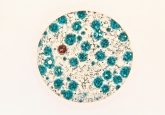Biomarkers as a diagnostic tool for PTSD

Four biomarkers, formerly linked to stress, depression, anxiety and mental health disorders, show promise for the development of biomarker-based diagnostic tools for PTSD. Blood samples from more than 1000 active-duty service members revealed associations between arginine, serotonin, glutamate and the glycolytic ratio and those suffering from PTSD. The findings of this new study were presented at the annual meeting of the American Society for Biochemistry and Molecular Biology (MD, USA).
Post traumatic stress disorder (PTSD) can be induced by experiencing or observing violence, injury or potential or actual death and is thought to affect the entire body, meaning that disease signals or biomarkers likely span genes, proteins, cells and tissues and even exhibits physiological changes at the organism-level. Dependency on self-reporting of PTSD by trauma survivors is problematic and often results in under reporting due to stigmatism or personal biases. Symptoms of PTSD can also overlap with other conditions and vary from re-experiencing trauma events, avoidance behavior, difficulty sleeping or focusing, memory issues, negative thoughts or moods associated with the event or hyperarousal. As a result, investment into diagnostic biomarker studies to objectively identify PTSD in candidates has increased.
In the largest prospective study to date, four biological markers of PTSD were assessed in more than 1000 active-duty service members. Blood samples were taken at three timepoints: before a 10-month deployment, three days after return and three to six months after return. The chosen biomarkers – the glycolytic ratio, arginine, serotonin and glutamate – have previously been linked to stress, depression, anxiety and mental health disorders.
Stacy-Ann Miller, researcher at Walter Reed Army Institute (MD, USA), commented:
“This study provides valuable insights into the natural history of PTSD and the effectiveness of interventions, which can inform the development of treatment guidelines and improve the care for individuals suffering from PTSD. Better methods of predicting or screening for PTSD could help to overcome the disorder by identifying individuals at high risk of developing PTSD and providing them with early intervention or prevention strategies. This could potentially reduce the severity of symptoms or prevent the disorder from developing altogether.”
You may also be interested in:
- Biomarker panel may diagnose post-traumatic stress disorder
- Connecting a common dietary supplement to reduced biomarker levels of Alzheimer’s disease in the brain
- A cup of Joe for good health: new biomarkers sought after in coffee consumption study
Participants were divided into cohorts based on their mental resilience and whether they had PTSD symptoms, sub-threshold PTSD or did not suffer from PTSD. When comparing the biomarkers in individuals from these groups, those with PTSD or sub-threshold PTSD had significantly higher glycolytic ratio and lower arginine. Individuals with PTSD also had significantly lower serotonin and higher glutamate than those identified as having high mental resilience. Both correlations were independent of age, gender, body mass index, smoking and caffeine consumption. These biomarkers could help to predict high risk individuals, improve the accuracy of PTSD diagnosis and improve general understanding of the drivers and effects of PTSD. Despite the progress made by this study, the authors have advised that additional research and validation is needed to confirm the biomarkers’ utility in real-world diagnostics.
“Improved methods of screening and predicting PTSD could inform better treatment approaches by providing a deeper understanding of the underlying biological mechanisms of the disorder,” said Miller. “This could lead to the development of more targeted and effective treatments for PTSD or to identify specific subtypes of PTSD, which may respond differently to different treatments.”
The study findings were presented on March 27 at the annual meeting of the American Society for Biochemistry and Molecular Biology.
Source: Eureka press release: https://www.eurekalert.org/news-releases/983057





